Cite this document
(“Bilingualism in Hong Kong schools Essay Example | Topics and Well Written Essays - 1750 words”, n.d.)
Retrieved from https://studentshare.org/miscellaneous/1559865-bilingualism-in-hong-kong-schools
Retrieved from https://studentshare.org/miscellaneous/1559865-bilingualism-in-hong-kong-schools
(Bilingualism in Hong Kong Schools Essay Example | Topics and Well Written Essays - 1750 Words)
https://studentshare.org/miscellaneous/1559865-bilingualism-in-hong-kong-schools.
https://studentshare.org/miscellaneous/1559865-bilingualism-in-hong-kong-schools.
“Bilingualism in Hong Kong Schools Essay Example | Topics and Well Written Essays - 1750 Words”, n.d. https://studentshare.org/miscellaneous/1559865-bilingualism-in-hong-kong-schools.


